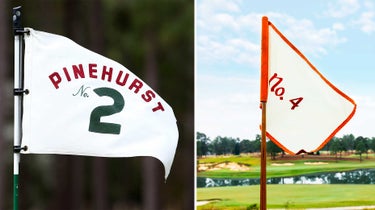
Gil Hanse is one of the most renowned course architects in the world.
Getty Images
PARAMUS, N.J. — Gil Hanse is a busy man.
The 59-year-old is one of the foremost golf-course architects in the world, and his fingerprints are everywhere in the game. From Olympic Club to Southern Hills to The Country Club (among many others), Hanse has left his mark.
This week’s U.S. Amateur host, Ridgewood Country Club, is no exception. Hanse led a restoration of the classic A.W. Tillinghast design back in the 90s, and three decades later, the course is as good as ever.
And despite the U.S. Amateur being one of the most hectic weeks in golf, Hanse made sure to carve out some time in his schedule to pop over to Ridgewood this week to take in a little of the action. On Wednesday, we found him following along early in the evening as Gordon Sargent and Ford Clegg battled into extra holes.
Hanse might be the busiest man in golf, but he was gracious enough to take a few minutes to chat about his favorite hole on property, the challenges of restoring classic courses and more.
Zephyr Melton: How do you feel the course is holding up so far this week?
Gil Hanse: It’s great so far. I think it’s presenting a really great challenge for these guys — the rough is thick and you’ve got to hit it straight. And I think for a U.S. Amateur that’s a great test. I think the thing that’s been interesting is that these greens have so much slope in them, that not only from a putting standpoint, but also from an approach standpoint, you’ve got to hit the ball to certain spots to get it to feed to where you want it to go. That’s been interesting to watch. The subtleties of the greens have been a challenge I’m sure.
ZM: Do you ever get nervous watching players compete on courses that you’ve had a hand in shaping?
GH: Not in this format, because it’s match play. No one is focused on what they shot — it’s just whoever wins, wins and you’ve got to get the ball in the hole. That’s a lot easier on the architect, because when you put score into the equation, then not only do you have your own expectations, but also the expectations of the members and if they think it’s playing too easy or too hard.
ZM: What’s your favorite hole out here on this championship routing?
GH: Well I always get the composite numbers wrong, but I’d say it’s No. 13, the par-5. I love that hole. Every once in a while, you’ll get a magazine or a book ask you “If there was a hole that you didn’t design that you wish you had, which would it be?” I’ve picked that hole a couple times. Just because of the beauty of it, the way the cross hazard comes into play. The mounds and the way they diagonally set. And with your second shot, if you play it close to the boundary, you open up the angle into the green, but if you play away from the trouble, you’ve got to come into the green with trouble. And the green in that little bowl I think is a beautoful setting. I’d definitely say that’s my favorite.
ZM: What are the challenges with restorations in keeping the essence of a course while also challenging the modern player?
GH: I think a lot of what challenges these guys is baked into the original design. It’s greens and contours of slopes and rough, of course. But I think where we have to reposition fairway bunkers, we would tend to do that if the topography allows us to shift them downrange to challenge the modern player. And with tees, we’ll extend them too, but not in a way that we would perceive as disconnecting holes — like if you had to walk 90 yards back and then walk the same 90 yards back to the fairway. That takes away the essence of these great old golf courses.
But one of the things that Jim Wagner and I have learned, is that if we trust Tillinghast and Donald Ross and George Thomas, 99 percent of the time, they got it right, and it’s still relevant to today’s player. So we try to keep as much of that as we can.
ZM: What makes a great golf hole?
GH: It’s having options. What makes a great golf hole in strategy is that the level of precision required to just go play is fairly low, with wide fairways and generous landing areas. But the level of precision required to score — meaning accessing hole locations and getting close and making birdies — means that you’re relying on angles and hazards and there’s a thought process to that. And that’s not easy to do, but it’s what we try to accomplish.
ZM: Last question — what’s harder: playing golf, or designing golf courses?
GH: Playing golf. (laughs) I seldom get frustrated designing golf courses, but I definitely get frustrated when playing.











